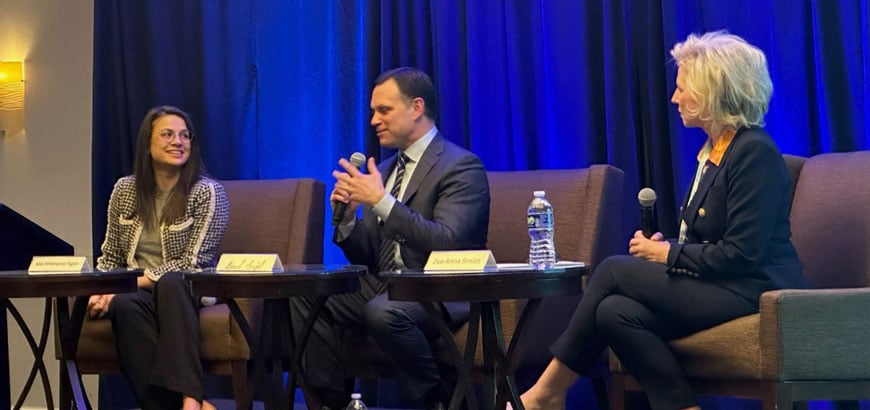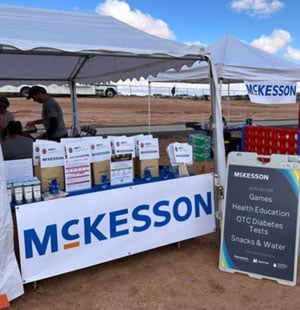
A McKesson employee and cancer survivor’s story of resilience and the power of empathy.

Guided by our values, we are an impact-driven organization that improves care in every setting – one product, one partner, one patient at a time.
Through our core commitments, we are leveraging our scale for the greater good, such as serving the needs of our stakeholders, donating back to our communities, protecting our planet, working with policymakers, and more.
Every year, we publish updates to our commitments through our Impact Report.
Download Our Impact ReportOur businesses bring together leading technologies, innovative solutions and hands-on expertise to support the entire healthcare ecosystem.
We distribute pharmaceuticals and medical supplies to healthcare settings across North America, from pharmacies and hospitals to doctors’ offices and clinics.
We help to ensure the financial wellbeing of pharmacies and health systems and support a stable work environment for their employees.
We provide research, insights, technologies and other support to help address challenges in cancer and specialty care.
We provide a suite of solutions designed to address access, affordability and adherence challenges by bridging the gaps between biopharma companies, pharmacies, providers, and payers to help patients get on and stay on their medications.
We offer solutions that enable employers, payers, health-plan brokers and government agencies to provide lower-cost options for prescription medications and therapies.
We help to ensure the financial wellbeing of pharmacies and health systems and support a stable work environment for their employees.
Every year, we publish updates to our commitments through our Impact Report.
Download Our Impact ReportInsights from the 2025 CoverMyMeds Medication Access Report, From Barriers to Bridges
Read Time
3 minutes

Imagine standing at the pharmacy counter waiting to get your medication only to be met with a price tag that feels impossible. For over half of patients across the U.S., that's the daily reality. And while cost concerns persist, a staggering 65% of patients encounter further, significant barriers in obtaining essential medications.1
However, it's not just patients who are affected by these challenges. Healthcare providers, including physicians and pharmacists, are also struggling to navigate the complexities of medication access. 94% of physicians say that the prior authorization process delays necessary patient care.2
These statistics highlight the importance of addressing the growing challenges of medication access from multiple angles — a central focus in the CoverMyMeds 2025 Medication Access Report, “From Barriers to Bridges." This report examines the current state of healthcare and offers key insights into how we can work together to help ensure that the evolution of healthcare leads to better health outcomes for all.
Below are key takeaways from this year’s report.
The Need for Dimensionalization in Patient Care
The concept of “dimensionalization” in patient care is all about acknowledging that the patient’s journey is not a straight line, but a complex web of interactions and experiences. This approach takes into account various aspects of a patient’s life, such as their social environment, economic status and personal health conditions, to create more personalized and effective treatment plans.
For patients, dimensionalization means receiving medication access support that’s more tailored to their individual circumstances. For healthcare stakeholders, including providers, pharmaceutical companies and insurers, dimensionalization encourages collaboration and the use of interoperable tools. It highlights the importance of data sharing and communication to help ensure that all parties involved in patient care are aligned and informed. For example, integrating behavioral services with medical care can help patients manage the non-medical factors that often impact their ability to adhere to treatment regimens.
Drug Pricing and Affordability
Patients with complex medical conditions often face significant financial challenges due to the high cost of medications, especially specialty drugs. These patients typically need several medications, and the overall expense can be daunting.
According to the Medication Access Report, specialty drugs make up 56% of total drug spending, even though they account for only 2% of prescriptions.3 This financial burden can force patients to change their prescriptions, leave the pharmacy without their medication, or pay out-of-pocket. Such financial pressure can lead to delays or skipping treatments, worsening health outcomes and ironically increasing healthcare costs over time.
Healthcare stakeholders can consider a variety of strategies to help break down these barriers:
The Evolution of Patient Support Programs
Pharmaceutical companies invest approximately $5 billion annually to help patients afford medications.4 However, these patient support programs (PSPs) have low utilization. The 2025 Medication Access Report states that 59% of patients and 42% of prescribers are unaware of PSPs.5 This lack of awareness can hinder patient care.
To improve PSP effectiveness, the report suggests collaboration across the healthcare ecosystem to invest in digital infrastructure, feedback mechanisms and patient data. For example, if patients have access to user-friendly platforms, can leverage telehealth with human support, and receive automated reminders, their engagement in programs will increase and ultimately so will overall program success.
To learn more about how CoverMyMeds is working to remove barriers to medication access, click here to access the full report.
1CoverMyMeds Patient Survey 2023.
2American Medical Association. “Health Insurance Denials, Delayed Care and Medication Access: How Prior Authorization Hurts Patients.” American Medical Association, 15 July 2024, www.ama-assn.org/practice-management/prior-authorization/health-insurance-denialsdelayed-care-and-medication-access
3Josh Nelson, Megan Preiner, Joan Thompson, and Ben Stern. “Navigating the Complexities of the Specialty Drug Market.” THL, 17 May 2024.
4Sohn, Adam, et al. “Making Patient Support EESI (EASY) Enhance, Empower, Simplify, Improve.” IQVIA, 12 July 2023.
5Bulik, Beth Snyder. “Pharmas’ Return on $5B Spent Yearly on Patient Support Programs? Only 3% Are Using Them: Survey.” Fierce Pharma, 6 July 2021.

A McKesson employee and cancer survivor’s story of resilience and the power of empathy.

CoverMyMeds acquires RxLightning and FastAuth to improve medication access for patients with critical medical conditions.

Ontada is an oncology technology and insights company committed to advancing cancer research and care by connecting life sciences partners, providers and patients.

Discover how McKesson Amplify is strengthening the voice of pharmacy professionals nationwide by awarding funding to every eligible state pharmacy association across all 50 states.

Top insights from the Endpoints at ASCO McKesson leadership panel

Insights and Takeaways for The Next Chapter in Specialty Medicine from Asembia AXS25

Enhancing patient access and engagement in clinical trials.

Learn how InspiroGene is helping deliver revolutionary cell and gene therapies to patients in need.

Insights from the 2025 CoverMyMeds Medication Access Report, From Barriers to Bridges

For two years in a row, McKesson has partnered with customers and industry partners to bring health education and awareness of resources to members of the Navajo community.